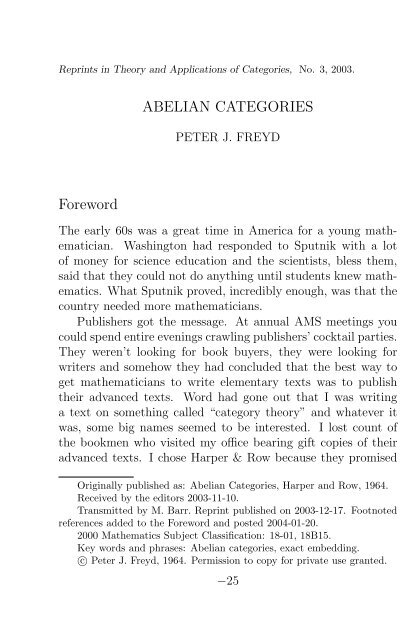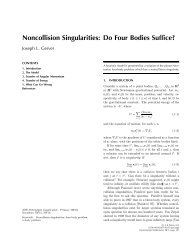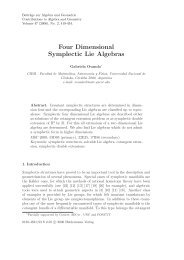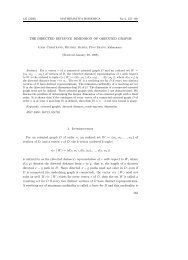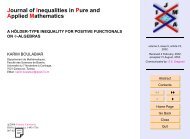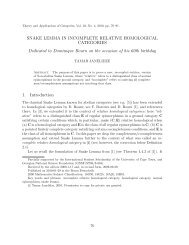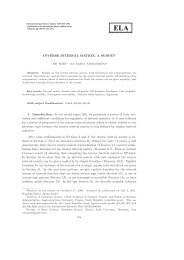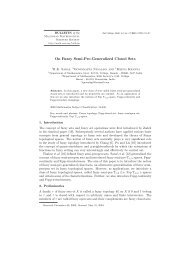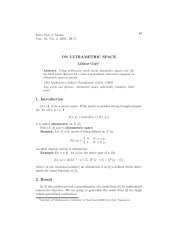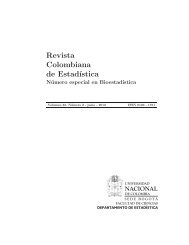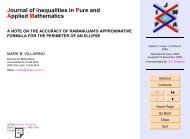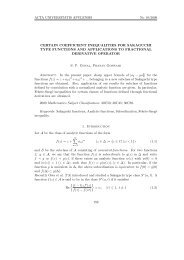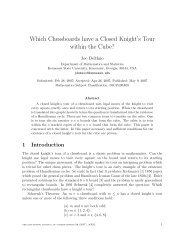ABELIAN CATEGORIES Foreword - FTP Directory Listing
ABELIAN CATEGORIES Foreword - FTP Directory Listing
ABELIAN CATEGORIES Foreword - FTP Directory Listing
Create successful ePaper yourself
Turn your PDF publications into a flip-book with our unique Google optimized e-Paper software.
Reprints in Theory and Applications of Categories, No. 3, 2003.<br />
<strong>Foreword</strong><br />
<strong>ABELIAN</strong> <strong>CATEGORIES</strong><br />
PETER J. FREYD<br />
The early 60s was a great time in America for a young mathematician.<br />
Washington had responded to Sputnik with a lot<br />
of money for science education and the scientists, bless them,<br />
said that they could not do anything until students knew mathematics.<br />
What Sputnik proved, incredibly enough, was that the<br />
country needed more mathematicians.<br />
Publishers got the message. At annual AMS meetings you<br />
could spend entire evenings crawling publishers’ cocktail parties.<br />
They weren’t looking for book buyers, they were looking for<br />
writers and somehow they had concluded that the best way to<br />
get mathematicians to write elementary texts was to publish<br />
their advanced texts. Word had gone out that I was writing<br />
a text on something called “category theory” and whatever it<br />
was, some big names seemed to be interested. I lost count of<br />
the bookmen who visited my office bearing gift copies of their<br />
advanced texts. I chose Harper & Row because they promised<br />
Originally published as: Abelian Categories, Harper and Row, 1964.<br />
Received by the editors 2003-11-10.<br />
Transmitted by M. Barr. Reprint published on 2003-12-17. Footnoted<br />
references added to the <strong>Foreword</strong> and posted 2004-01-20.<br />
2000 Mathematics Subject Classification: 18-01, 18B15.<br />
Key words and phrases: Abelian categories, exact embedding.<br />
c○ Peter J. Freyd, 1964. Permission to copy for private use granted.<br />
−25
PETER J. FREYD<br />
a low price (≤ $8) and—even better—hundreds of free copies to<br />
mathematicians of my choice. (This was to be their first math<br />
publication.)<br />
On the day I arrived at Harper’s with the finished manuscript<br />
I was introduced, as a matter of courtesy, to the Chief of Production<br />
who asked me, as a matter of courtesy, if I had any<br />
preferences when it came to fonts and I answered, as a matter<br />
of courtesy, with the one name I knew, New Times Roman.<br />
It was not a well-known font in the early 60s; in those days<br />
one chose between Pica and Elite when buying a typewriter—not<br />
fonts but sizes. The Chief of Production, no longer acting just on<br />
courtesy, told me that no one would choose it for something like<br />
mathematics: New Times Roman was believed to be maximally<br />
dense for a given level of legibility. Mathematics required a more<br />
spacious font. All that was news to me; I had learned its name<br />
only because it struck me as maximally elegant.<br />
The Chief of Production decided that Harper’s new math<br />
series could be different. Why not New Times Roman? The<br />
book might be even cheaper than $8 (indeed, it sold for $7.50).<br />
We decided that the title page and headers should be sans serif<br />
and settled that day on Helvetica (it ended up as a rather nonstandard<br />
version). Harper & Row became enamored with those<br />
particular choices and kept them for the entire series. (And—<br />
coincidently or not—so, eventually, did the world of desktop<br />
publishing.) The heroic copy editor later succeeded in convincing<br />
the Chief of Production that I was right in asking for negative<br />
page numbering. The title page came in at a glorious –11<br />
and—best of all—there was a magnificent page 0.<br />
The book’s sales surprised us all; a second printing was ordered.<br />
(It took us a while to find out who all the extra buyers<br />
were: computer scientists.) I insisted on a number of changes<br />
−24
<strong>ABELIAN</strong> <strong>CATEGORIES</strong><br />
(this time Harper’s agreed to make them without deducting from<br />
my royalties; the correction of my left-right errors—scores of<br />
them—for the first printing had cost me hundreds of dollars).<br />
But for reasons I never thought to ask about, Harper’s didn’t<br />
mark the second printing as such. The copyright page, –8, is almost<br />
identical, even the date. (When I need to determine which<br />
printing I’m holding—as, for example, when finding a copy for<br />
this third “reprinting”—I check the last verb on page –3. In the<br />
second printing it is has instead of have).<br />
A few other page-specific comments:<br />
Page 8: Yikes! In the first printing there’s no definition of<br />
natural equivalence. Making room for it required much shortening<br />
of this paragraph from the first printing:<br />
Once the definitions existed it was quickly noticed<br />
that functors and natural transformations had become<br />
a major tool in modern mathematics. In 1952<br />
Eilenberg and Steenrod published their Foundations<br />
of Algebraic Topology [7], an axiomatic approach to<br />
homology theory. A homology theory was defined<br />
as a functor from a topological category to an algebraic<br />
category obeying certain axioms. Among the<br />
more striking results was their classification of such<br />
“theories,” an impossible task without the notion of<br />
natural equivalence of functors. In a fairly explosive<br />
manner, functors and natural transformations have<br />
permeated a wide variety of subjects. Such monumental<br />
works as Cartan and Eilenberg’s Homological<br />
Algebra [4], and Grothendieck’s Elements of Algebraic<br />
Geometry [1] testify to the fact that functors<br />
have become an established concept in mathematics.<br />
Page 21: The term “difference kernel” in 1.6 was doomed, of<br />
−23
PETER J. FREYD<br />
course, to be replaced by the word “equalizer”.<br />
Pages 29–30: Exercise 1–D would have been much easier if<br />
it had been delayed until after the definitions of generator and<br />
pushout. The category [→] is best characterized as a generator<br />
for the category of small categories that appears as a retract of<br />
every other generator. The category [→→] is a pushout of the<br />
two maps from 1 to [→] and this characterization also simplifies<br />
the material in section 3: if a functor fixes the two maps<br />
from 1 to [→] then it will be shown to be equivalent to the<br />
identity functor; if, instead, it twists them it is equivalent to the<br />
dual-category functor. These characterizations have another advantage:<br />
they are correct. If one starts with the the two-element<br />
monoid that isn’t a group, views it as a category and then formally<br />
“splits the idempotents” (as in Exercise 2–B, page 61) the<br />
result is another two-object category with exactly three endofunctors.<br />
And the supposed characterization of [→→] is counterexampled<br />
by the disjoint union of [→] and the cyclic group<br />
of order three.<br />
Page 35: The axioms for abelian categories are redundant:<br />
either A 1 or A 1* suffices, that is, each in the presence of the<br />
other axioms implies the other. The proof, which is not straightforward,<br />
can be found on section 1.598 of my book with Andre<br />
Scedrov 1 , henceforth to be referred to as Cats & Alligators. Section<br />
1.597 of that book has an even more parsimonious definition<br />
of abelian category (which I needed for the material described<br />
below concerning page 108): it suffices to require either products<br />
or sums and that every map has a “normal factorization”,<br />
to wit, a map that appears as a cokernel followed by a map that<br />
appears as kernel.<br />
Pages 35–36: Of the examples mentioned to show the in-<br />
1 Categories, Allegories, North Holland, 1990<br />
−22
<strong>ABELIAN</strong> <strong>CATEGORIES</strong><br />
dependence of A 3 and A 3* one is clear, the other requires<br />
work: it is not exactly trivial that epimorphisms in the category<br />
of groups (abelian or not) are onto—one needs the “amalgamation<br />
lemma”. (Given the symmetry of the axioms either one of<br />
the examples would, note, have sufficed.) For the independence<br />
of A 2 (hence, by taking its dual, also of A 2*) let R be a<br />
ring, commutative for convenience. The full subcategory, F, of<br />
finitely presented R-modules is easily seen to be closed under<br />
the formation of cokernels of arbitrary maps—quite enough for<br />
A 2* and A 3. With a little work one can show that the kernel<br />
of any epi in F is finitely generated which guarantees that it is<br />
the image of a map in F and that’s enough for A 3*. The necessary<br />
and sufficient condition that F satisfy A 2 is that R be<br />
“coherent”, that is, all of its finitely generated ideals be finitely<br />
presented as modules. For present purposes we don’t need the<br />
necessary and sufficient condition. So: let K be a field and R be<br />
the result of adjoining a sequence of elements Xn subject to the<br />
condition that XiXj = 0 all i, j. Then multiplication by, say,<br />
X1 defines an endomorphism on R, the kernel of which is not<br />
finitely generated. More to the point, it fails to have a kernel in<br />
F.<br />
Page 60: Exercise 2–A on additive categories was entirely<br />
redone for the second printing. Among the problems in the first<br />
printing were the word “monoidal” in place of “pre-additive”<br />
(clashing with the modern sense of monoidal category) and—<br />
would you believe it!—the absence of the distributive law.<br />
Page 72: A reviewer mentioned as an example of one of my<br />
private jokes the size of the font for the title of section 3.6,<br />
bifunctors. Good heavens. I was not really aware of how<br />
many jokes (private or otherwise) had accumulated in the text;<br />
I must have been aware of each one of them in its time but<br />
−21
PETER J. FREYD<br />
I kept no track of their number. So now people were seeking<br />
the meaning for the barely visible slight increase in the size of<br />
the word bifunctors on page 72. If the truth be told, it was<br />
from the first sample page the Chief of Production had sent me<br />
for approval. Somewhere between then and when the rest of<br />
the pages were done the size changed. But bifunctors didn’t<br />
change. At least not in the first printing. Alas, the joke was<br />
removed in the second printing.<br />
Pages 75–77: Note, first, that a root is defined in Exercise<br />
3–B not as an object but as a constant functor. There was<br />
a month or two in my life when I had come up with the notion<br />
of reflective subcategories but had not heard about adjoint<br />
functors and that was just enough time to write an undergraduate<br />
honors thesis 2 . By constructing roots as coreflections into<br />
the categories of constant functors I had been able to prove the<br />
equivalence of completeness and co-completeness (modulo, as I<br />
then wrote, “a set-theoretic condition that arises in the proof”).<br />
The term “limit” was doomed, of course, not to be replaced by<br />
“root”. Saunders Mac Lane predicted such in his (quite favorable)<br />
review 3 , thereby guaranteeing it. (The reasons I give on<br />
page 77 do not include the really important one: I could not<br />
for the life of me figure out how A×B results from a limiting<br />
process applied to A and B. I still can’t.)<br />
Page 81: Again yikes! The definition of representable functors<br />
in Exercise 4–G appears only parenthetically in the first<br />
printing. When rewritten to give them their due it was necessary<br />
to remove the sentence “To find A, simply evaluate the<br />
left-adjoint of S on a set with a single element.” The resulting<br />
2 Brown University, 1958<br />
3 The American Mathematical Monthly, Vol. 72, No. 9. (Nov., 1965),<br />
pp. 1043-1044.<br />
−20
<strong>ABELIAN</strong> <strong>CATEGORIES</strong><br />
paragraph is a line shorter; hence the extra space in the second<br />
printing.<br />
Page 84: After I learned about adjoint functors the main<br />
theorems of my honors thesis mutated into a chapter about the<br />
general adjoint functor theorems in my Ph.D. dissertation 4 . I<br />
was still thinking, though, in terms of reflective subcategories<br />
and still defined the limit (or, if you insist, the root) of D → A<br />
as its reflection in the subcategory of constant functors. If I had<br />
really converted to adjoint functors I would have known that<br />
limits of functors in A D should be defined via the right adjoint<br />
of the functor A → A D that delivers constant functors. Alas,<br />
I had not totally converted and I stuck to my old definition in<br />
Exercise 4–J. Even if we allow that the category of constant<br />
functors can be identified with A we’re in trouble when D is<br />
empty: no empty limits. Hence the peculiar “condition zero” in<br />
the statement of the general adjoint functor theorem and any<br />
number of requirements to come about zero objects and such,<br />
all of which are redundant when one uses the right definition of<br />
limit.<br />
There is one generalization of the general adjoint functor theorem<br />
worth mentioning here. Let “weak-” be the operator on<br />
definitions that removes uniqueness conditions. It suffices that<br />
all small diagrams in A have weak limits and that T preserves<br />
them. See section 1.8 of Cats & Alligators. (The weakly complete<br />
categories of particular interest are in homotopy theory. A<br />
more categorical example is coscanecof, the category of small<br />
categories and natural equivalence classes of functors.)<br />
Pages 85–86: Only once in my life have I decided to refrain<br />
from further argument about a non-baroque matter in mathematics<br />
and that was shortly after the book’s publication: I<br />
4 Princeton, 1960<br />
−19
PETER J. FREYD<br />
refused to engage in the myriad discussions about the issues discussed<br />
in the material that starts on the bottom of page 85. It<br />
was a good rule. I had (correctly) predicted that the controversy<br />
would evaporate and that, in the meantime, it would be a<br />
waste of time to amplify what I had already written. I should,<br />
though, have figured out a way to point out that the forgetful<br />
functor for the category, B, described on pages 131–132 has all<br />
the conditions needed for the general adjoint functor except for<br />
the solution set condition. Ironically there was already in hand a<br />
much better example: the forgetful functor from the category of<br />
complete boolean algebras (and bi-continuous homomorphisms)<br />
to the category of sets does not have a left adjoint (put another<br />
way, free complete boolean algebras are non-existently large).<br />
The proof (albeit for a different assertion) was in Haim Gaifman’s<br />
1962 dissertation 5 .<br />
Page 87: The term “co-well-powered” should, of course, be<br />
“well-co-powered”.<br />
Pages 91–93: I lost track of the many special cases of Exercise<br />
3–O on model theory that have appeared in print (most often<br />
in proofs that a particular category, for example the category of<br />
semigroups, is well-co-powered and in proofs that a particular<br />
category, for example the category of small skeletal categories,<br />
is co-complete). In this exercise the most conspicuous omission<br />
resulted from my not taking the trouble to allow many-sorted<br />
theories, which meant that I was not able to mention the easy<br />
theorem that B A is a category of models whenever A is small<br />
and B is itself a category of models.<br />
Page 107: Characteristic zero is not needed in the first half<br />
of Exercise 4–H. It would be better to say that a field arising<br />
as the ring of endomorphisms of an abelian group is necessar-<br />
5 Infinite Boolean Polynomials I. Fund. Math. 54 1964<br />
−18
<strong>ABELIAN</strong> <strong>CATEGORIES</strong><br />
ily a prime field (hence the category of vector spaces over any<br />
non-prime field can not be fully embedded in the category of<br />
abelian groups). The only reason I can think of for insisting on<br />
characteristic zero is that the proofs for finite and infinite characteristics<br />
are different—a strange reason given that neither proof<br />
is present.<br />
Page 108: I came across a good example of a locally small<br />
abelian category that is not very abelian shortly after the second<br />
printing appeared: to wit, the target of the universal homology<br />
theory on the category of connected cw-complexes (finite<br />
dimensional, if you wish). Joel Cohen called it the “Freyd category”<br />
in his book 6 , but it should be noted that Joel didn’t<br />
name it after me. (He always insisted that it was my daughter.)<br />
It’s such a nice category it’s worth describing here. To<br />
construct it, start with pairs of cw-complexes 〈X ′ , X〉 where X ′<br />
is a non-empty subcomplex of X and take the obvious condition<br />
on maps, to wit, f : 〈X ′ , X〉 → 〈Y ′ , Y 〉 is a continuous map<br />
f : X → Y such that f(X ′ ) ⊆ Y ′ . Now impose the congruence<br />
that identifies f, g : 〈X ′ , X〉 → 〈Y ′ , Y 〉 when f|X ′ and g|X ′ are<br />
homotopic (as maps to Y ). Finally, take the result of formally<br />
making the suspension functor an automorphism (which can, of<br />
course, be restated as taking a reflection). This can all be found<br />
in Joel’s book or in my article with the same title as Joel’s 7 .<br />
The fact that it is not very abelian follows from the fact that<br />
the stable-homotopy category appears as a subcategory (to wit,<br />
the full subcategory of objects of the form 〈X, X〉) and that<br />
category was shown not to have any embedding at all into the<br />
6Stable Homotopy Lecture Notes in Mathematics Vol.<br />
Verlag, Berlin-New York 1970<br />
165 Springer-<br />
7Stable Homotopy, Proc. of the Conference of Categorical Algebra,<br />
Springer-Verlag, 1966<br />
−17
PETER J. FREYD<br />
category of sets in Homotopy Is Not Concrete 8 . I was surprised,<br />
when reading page 108 for this <strong>Foreword</strong>, to see how similar in<br />
spirit its set-up is to the one I used 5 years later to demonstrate<br />
the impossibility of an embedding of the homotopy category.<br />
Page (108): Parenthetically I wrote in Exercise 4–I, “The<br />
only [non-trivial] embedding theorem for large abelian categories<br />
that we know of [requires] both a generator and a cogenerator.”<br />
It took close to ten more years to find the right theorem: an<br />
abelian category is very abelian iff it is well powered (which it<br />
should be noticed, follows from there being any embedding at all<br />
into the category of sets, indeed, all one needs is a functor that<br />
distinguishes zero maps from non-zero maps). See my paper<br />
Concreteness 9 . The proof is painful.<br />
Pages 118–119: The material in small print (squeezed in<br />
when the first printing was ready for bed) was, sad to relate,<br />
directly disbelieved. The proofs whose existence are being asserted<br />
are natural extensions of the arguments in Exercise 3–O<br />
on model theory (pages 91–93) as suggested by the “conspicuous<br />
omission” mentioned above. One needs to tailor Lowenheim-<br />
Skolem to allow first-order theories with infinite sentences. But<br />
it is my experience that anyone who is conversant in both model<br />
theory and the adjoint-functor theorems will, with minimal prodding,<br />
come up with the proofs.<br />
Pages 130–131: The Third Proof in the first printing was<br />
hopelessly inadequate (and Saunders, bless him, noticed that<br />
fact in his review). The proof that replaced it for the second<br />
printing is ok. Fitting it into the alloted space was, if I may say<br />
so, a masterly example of compression.<br />
8 The Steenrod Algebra and its Applications, Lecture Notes in Mathematics,<br />
Vol. 168 Springer, Berlin 1970<br />
9 J. of Pure and Applied Algebra, Vol. 3, 1973<br />
−16
<strong>ABELIAN</strong> <strong>CATEGORIES</strong><br />
Pages 131–132: The very large category B (Exercise 6–A)—<br />
with a few variations—has been a great source of counterexamples<br />
over the years. As pointed out above (concerning pages<br />
85–86) the forgetful functor is bi-continuous but does not have<br />
either adjoint. To move into a more general setting, drop the<br />
condition that G be a group and rewrite the “convention” to<br />
become f(y) = 1G for y /∈ S (and, of course, drop the condition<br />
that h : G → G ′ be a homomorphism—it can be any function).<br />
The result is a category that satisfies all the conditions of a<br />
Grothendieck topos except for the existence of a generating set.<br />
It is not a topos: the subobject classifier, Ω, would need to be the<br />
size of the universe. If we require, instead, that all the values of<br />
all f : S → (G, G) be permutations, it is a topos and a boolean<br />
one at that. Indeed, the forgetful functor preserves all the relevant<br />
structure (in particular, Ω has just two elements). In its<br />
category of abelian-group objects—just as in B—Ext(A, B) is a<br />
proper class iff there’s a non-zero group homomorphism from A<br />
to B (it needn’t respect the actions), hence the only injective object<br />
is the zero object (which settled a once-open problem about<br />
whether there are enough injectives in the category of abelian<br />
groups in every elementary topos with natural-numbers object.)<br />
Pages 153–154: I have no idea why in Exercise 7–G I didn’t<br />
cite its origins: my paper, Relative Homological Algebra Made<br />
Absolute 10 .<br />
Page 158: I must confess that I cringe when I see “A man<br />
learns to think categorically, he works out a few definitions, perhaps<br />
a theorem, more likely a lemma, and then he publishes it.”<br />
I cringe when I recall that when I got my degree, Princeton had<br />
never allowed a female student (graduate or undergraduate). On<br />
the other hand, I don’t cringe at the pronoun “he”.<br />
10 Proc. Nat. Acad. Sci., Feb. 1963<br />
−15
PETER J. FREYD<br />
Page 159: The Yoneda lemma turns out not to be in Yoneda’s<br />
paper. When, some time after both printings of the book appeared,<br />
this was brought to my (much chagrined) attention, I<br />
brought it the attention of the person who had told me that it<br />
was the Yoneda lemma. He consulted his notes and discovered<br />
that it appeared in a lecture that Mac Lane gave on Yoneda’s<br />
treatment of the higher Ext functors. The name “Yoneda lemma”<br />
was not doomed to be replaced.<br />
Pages 163–164: Allows and Generating were missing in the<br />
index of the first printing as was page 129 for Mitchell. Still<br />
missing in the second printing are Natural equivalence, 8 and<br />
Pre-additive category, 60. Not missing, alas, is Monoidal category.<br />
FINALLY, a comment on what I “hoped to be a geodesic<br />
course” to the full embedding theorem (mentioned on page 10).<br />
I think the hope was justified for the full embedding theorem,<br />
but if one settles for the exact embedding theorem then the<br />
geodesic course omitted an important development. By broadening<br />
the problem to regular categories one can find a choice-free<br />
theorem which—aside from its wider applicability in a topostheoretic<br />
setting—has the advantage of naturality. The proof<br />
requires constructions in the broader context but if one applies<br />
the general construction to the special case of abelian categories,<br />
we obtain:<br />
There is a construction that assigns to each small abelian category<br />
A an exact embedding into the category of abelian groups<br />
A → G such that for any exact functor A → B there is a natural<br />
assignment of a natural transformation from A → G to<br />
A → B → G. When A → B is an embedding then so is the<br />
transformation.<br />
The proof is suggested in my pamphlet On canonizing cat-<br />
−14
<strong>ABELIAN</strong> <strong>CATEGORIES</strong><br />
egory theory or on functorializing model theory 11 . It uses the<br />
strange subject of τ-categories. More accessibly, it is exposed in<br />
section 1.54 of Cats & Alligators.<br />
<br />
–<br />
Philadelphia<br />
November 18, 2003<br />
11 Mimeographed notes, Univ. Pennsylvania, Philadelphia, Pa., 1974<br />
−13
REPRINTS IN THEORY AND APPLICATIONS OF <strong>CATEGORIES</strong> will<br />
disseminate articles from the body of important literature in Category Theory<br />
and closely related subjects which have never been published in journal<br />
form, or which have been published in journals whose narrow circulation<br />
makes access very difficult. Publication in ‘Reprints in Theory and Applications<br />
of Categories’ will permit free and full dissemination of such<br />
documents over the Internet.<br />
Articles appearing have been critically reviewed by the Editorial Board<br />
of Theory and Applications of Categories. Only articles of lasting significance<br />
are considered for publication.<br />
Distribution is via the Internet tools WWW/ftp.<br />
Subscription information. Individual subscribers receive (by email)<br />
abstracts of articles as they are published. To subscribe, send e-mail<br />
to tac@mta.ca including a full name and postal address. For institutional<br />
subscription, send enquiries to the Managing Editor, Robert Rosebrugh,<br />
rrosebrugh@mta.ca.<br />
Information for authors. After obtaining written permission<br />
from any copyright holder, an author, or other member of the community,<br />
may propose an article to a TAC Editor for TAC Reprints. TAC Editors<br />
are listed below. When an article is accepted, the author, or other proposer,<br />
will be required to provide to TAC either a usable TeX source for the article<br />
or a PDF document acceptable to the Managing Editor that reproduces a<br />
typeset version of the article. Up to five pages of corrections, commentary<br />
and forward pointers may be appended by the author. Please obtain detailed<br />
information on TAC format and style files from the journal’s WWW<br />
server at http://www.tac.mta.ca/tac/.<br />
Editorial board.<br />
John Baez, University of California, Riverside: baez@math.ucr.edu<br />
Michael Barr, McGill University: barr@barrs.org, Associate Managing<br />
Editor<br />
Lawrence Breen, Université Paris 13: breen@math.univ-paris13.fr<br />
Ronald Brown, University of North Wales: r.brown@bangor.ac.uk<br />
Jean-Luc Brylinski, Pennsylvania State University: jlb@math.psu.edu<br />
Aurelio Carboni, Università dell Insubria: aurelio.carboni@uninsubria.it<br />
P. T. Johnstone, University of Cambridge: ptj@dpmms.cam.ac.uk<br />
G. Max Kelly, University of Sydney: maxk@maths.usyd.edu.au<br />
Anders Kock, University of Aarhus: kock@imf.au.dk
F. William Lawvere, S.U.N.Y. at Buffalo: wlawvere@acsu.buffalo.edu<br />
Jean-Louis Loday, Université de Strasbourg: loday@math.u-strasbg.fr<br />
Ieke Moerdijk, University of Utrecht: moerdijk@math.uu.nl<br />
Susan Niefield, Union College: niefiels@union.edu<br />
Robert Paré, Dalhousie University: pare@mathstat.dal.ca<br />
Andrew Pitts, University of Cambridge: Andrew.Pitts@cl.cam.ac.uk<br />
Robert Rosebrugh, Mount Allison University: rrosebrugh@mta.ca, Managing<br />
Editor<br />
Jiri Rosicky, Masaryk University: rosicky@math.muni.cz<br />
James Stasheff, University of North Carolina: jds@math.unc.edu<br />
Ross Street, Macquarie University: street@math.mq.edu.au<br />
Walter Tholen, York University: tholen@mathstat.yorku.ca<br />
Myles Tierney, Rutgers University: tierney@math.rutgers.edu<br />
Robert Walters, University of Insubria: robert.walters@uninsubria.it<br />
R. J. Wood, Dalhousie University: rjwood@mathstat.dal.ca<br />
This reprint may be accessed from<br />
http://www.tac.mta.ca/tac/tacreprints


